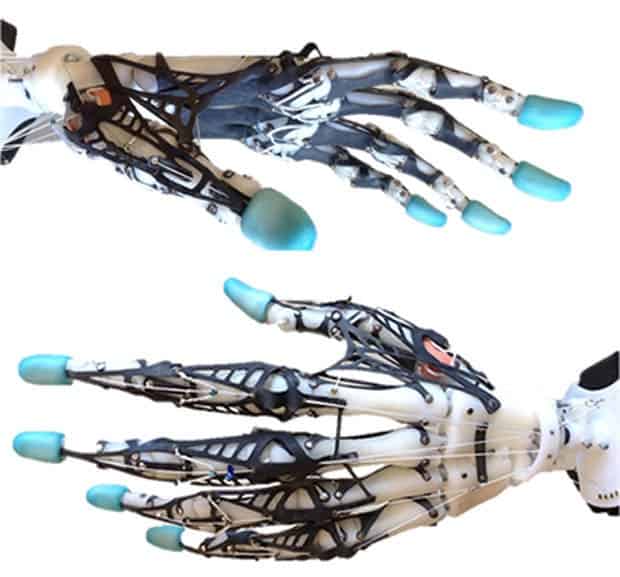Most modern prosthetics try to look like the real deal, while still featuring underlying robotics. Two researchers at the University of Washington’s Department of Computer Science & Engineering wanted to try another approach – to create a hand that acts like its biological equivalent, even though it may not look like one.
In order to do this, they looked at the human hand as if it were just a mechanical device. They took scans of the bones and muscles and then 3D printed copies to make it as realistic as possible. The idea was to make the structure of the prosthetic based on the structure of the human bones. They also implemented pulley mechanisms, artificial joint capsules, crocheted ligaments and tendons, and other devices for this task. According to IEEE, joint ligaments (which stabilize joints and control their range of motion) are made of high strength Spectra strings, with laser-cut rubber sheets replacing the soft tissues that add joint compliance. Extensor and flexor tendons (for straightening and bending fingers) are also made of Spectra, with more laser-cut rubber sheets for the tendon sheathing and extensor hood, which is a complex webbed multi-layered structure that wraps around the fingers to help manage flexibility and torque.
There’s not detail available about this at the moment, because a paper hasn’t been presented yet.The paper that will be presented at the ICRA in Stockholm, Sweden this coming May: Design of a Highly Biomimetic Anthropomorphic Robotic Hand towards Artificial Limb Regeneration.

Image: Movement Control Laboratory/University of Washington
According to Zhe Xu, one of the two researchers working on this project, believes that developing true antropomorphic prosthetics is key to developing proper dexterity:
“The conventional approach to designing anthropomorphic robotic hands often involves mechanizing biological parts with hinges, linkages, and gimbals in order to simplify the seemingly complicated human counterparts. This approach is helpful for understanding and approximating the kinematics of the human hand in general, but inevitably introduces undesirable discrepancies between the human and robotic hands since most of those salient biomechanical features of the human hand are discarded in the mechanizing process. The inherent mismatch between mechanisms of these robotic hands and biomechanics of human hands essentially prevents us from using natural hand motion to directly control them. Thus none of the existing anthropomorphic robotic hands can achieve the human-level dexterity yet.”
He also says that this type of technology could be used as a “scaffolding” to help with limb regeneration research.
“The control of prosthetic hands essentially relies on human brain. Therefore the same neuroprosthetic technologies could be more effective if the design of the prosthesis could be more similar to its biological counterpart. Biocompatible materials can now be printed to form bone structures, biodegradable artificial ligaments have been used to replace the torn anterior cruciate ligaments, human muscles have been successfully cultivated inside petri dish, and peripheral nerves can also be regenerated given the right conditions. All of the these promising technologies require suitable scaffolds for the growth of grafted cells. We are going to collaborate with researchers from biology and tissue engineering to further explore its potential to serve as a bio-fabricated device/scaffold in the emerging fields of neuroprosthetics and limb regeneration.”









